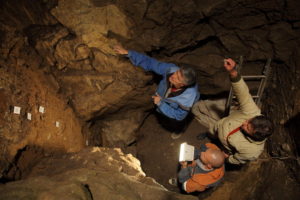Genetic analysis of bones discovered in a Siberian cave hints that the prehistoric world may have been filled with “hybrid” humans.
Original article by By Carl Zimmer posted on Aug 22, 2018
In a limestone cave nestled high above the Anuy River in Siberia, scientists have discovered the fossil of an extraordinary human hybrid.
The 90,000-year-old bone fragment came from a female whose mother was Neanderthal, according to an analysis of DNA discovered inside it. But her father was not: He belonged to another branch of ancient humanity known as the Denisovans.
Scientists have been recovering genomes from ancient human fossils for just over a decade. Now, with the discovery of a Neanderthal-Denisovan hybrid, the world as it was tens of thousands of years ago is coming into remarkable new focus: home to a marvelous range of human diversity.

Clockwise from top, researchers Richard Roberts, Vladimir Ulianov and Maxim Kozlikin in a chamber of the Denisova cave in Siberia, where the fossil of a 90,000-year-old human hybrid was discovered.
In 2010, researchers working in the Siberian cave, called Denisova, announced they had found DNA from a scrap of bone representing an unknown group of humans. Subsequent discoveries in the cave confirmed that the Denisovans were a lineage distinct from modern humans.
Scientists can’t yet say what Denisovans looked like or how they behaved, but it’s clear they were separated from Neanderthals and modern humans by hundreds of thousands of years of evolution.
Until now, scientists had indirect clues that Neanderthals, Denisovans and modern humans interbred, at least a few times. But the new study, published on Wednesday in the journal Nature, offers clear evidence.
“They managed to catch it in the act — it’s an amazing discovery,” said Sharon Browning, a statistical geneticist at the University of Washington who was not involved in the new study.
What makes the discovery all the more remarkable is that scientists didn’t have to look all that long to find a hybrid. Until today, scientists had discovered only four Denisovans; the fifth turned out to be a first-generation hybrid.
[Like the Science Times page on Facebook. | Sign up for the Science Times newsletter.]
Hybrids may not have been all that uncommon. In 2015, researchers discovered that a modern human who lived in what is now Romania 40,000 years ago had a great-great-grandparent who was Neanderthal.
The discovery in 2010 of the first Denisovan fossil (called Denisova 3) spurred Russian researchers to carry out a more systematic exploration of the cave floor. It is littered with bone fragments, deposited in sedimentary layers.
Many of those mysterious fragments were sent to Svante Paabo, a renowned geneticist and the director of the Max Planck Institute for Evolutionary Anthropology in Leipzig, Germany.
The cave, it turned out, had a long history of occupation. The researchers found the genome of a Neanderthal in a toe bone dating back 120,000 years.
Denisovans appeared later, and from the fossils alone it was hard for scientists to know if Denisovans and Neanderthals had ever come into contact. But their DNA hinted at one union, at least: Denisova 3’s genome, researchers discovered, contained traces of Neanderthal DNA.
The newly discovered hybrid came to the attention of Dr. Paabo’s team in 2014, when Russian collaborators sent his team 2,000 badly damaged bone fragments from the cave.
“You can’t even tell if they’re human or animal,” Dr. Paabo said in an interview.
He and his colleagues extracted collagen from the bones and compared the protein to that of living species. Only one fragment had collagen that resembled our own.
That fragment came from an arm or leg bone — it’s impossible to say which. The bone is thick, which means that it belonged to someone at least 13 years old.
Viviane Slon, then a graduate student at the institute, led a search for DNA in the fragment. She began by hunting for a special set of genes found in the fuel-generating factories of the cell, called mitochondria.
Mitochondria carry a set of genes distinct from those of the cell’s nucleus; these genes, unlike those in the nucleus, are inherited solely from the mother.
In 2016, Dr. Slon and her colleagues reported that they had gotten mitochondrial DNA from the mysterious bone fragment, and that it closely matched genetic material from Neanderthals.

A view of a valley beyond the Denisova cave archaeological site.
The researchers called that individual Denisova 11, and they began searching the bone for nuclear DNA. Fragment by fragment, they began reconstructing the entire genome.
Strangely, only some of the fragments of nuclear DNA matched Neanderthal genes. There was just as much Denisovan DNA in the bone.
“I was wondering, ‘What did I do wrong?’” recalled Dr. Slon, now a postdoctoral researcher at the institute.
In each pair of chromosomes, one came from a Neanderthal, the other from a Denisovan. This individual, she and her colleagues concluded, was a hybrid. “It was a good proof that this was real,” she said.
An examination of the X chromosome showed that Denisova 11 was female. As for which parent was which, the mitochondrial DNA held the answer: Since these genes are only passed down from mothers, Denisova 11’s mother was Neanderthal.
Her Denisovan father’s kin were local, it turned out. His DNA most closely resembles the genetic material from Denisova 3’s pinky, discovered at the cave in 2010. She lived in the cave a few thousand years after Denisova 11, the hybrid human.
Her Neanderthal mother, however, was closely related to Neanderthals who lived thousands of miles to the west in what is now Croatia, 20,000 years after Denisova 11 died. She was only distantly related to the Neanderthals who lived in the cave 120,000 years ago.
“It seems like Neanderthals were moving around quite a bit,” said Dr. Browning.
Dr. Paabo said it’s not possible to figure out why the Neanderthals traveled, or when, until more genomes are discovered.
Despite interbreeding, Neanderthals and Denisovans never merged into a single genetic population. For hundreds of thousands of years, they remained distinct.
It’s possible they simply didn’t have much opportunity to mate because they lived in small groups spread out across a vast landscape, Dr. Paabo suggested.
“They didn’t meet that often, but when they met they seemed to not have prejudices against each other and mixed freely,” he said.
It’s also possible that hybrids suffered from reproductive disorders, having fewer children than humans without mixed DNA.
Broader interbreeding may have gained momentum when modern humans emerged from Africa roughly 70,000 years ago.
Modern humans lived in bigger, denser groups than Neanderthals or Denisovans, and they moved quickly across Europe and Asia. Recent archaeological digs suggest they reached Australia as early as 65,000 years ago.
